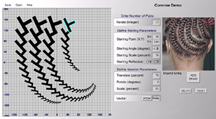
« PREVIOUS ENTRY
Realdolls, and the men who love them
NEXT ENTRY »
Do iPods help Olympic athletes perform better?

Complex mathematical concepts are difficult to teach, so textbooks frequently try to explain things by referring to everyday phenomenon. But textbooks are often pretty culturally specific, so it’s hard to translate them from one country to another — or even from one cultural group to another. A textbook written using farm examples from rural Idaho ain’t gonna cut it with kids in New York who’ve never even seen a tree, and vice versa. So the trick is to find relevant culture that also represents high-end math.
Such as … cornrow hair braids. Some educators realized that cornrows were a great example of fractal geometry, and developed some software that illustrates how it works. Ron Eglash of the Rensselaer Polytechnic Institute wrote about it on his web site:
Each braid is represented as multiple copies of a “Y” shaped plait. In each iteration, the plait is copied, and a transformation is applied. The series of transformed copies creates the braid. In the above example, we can see the original style at top right, and a series of braid simulations, each composed of plait copies that are successively scaled down, rotated, and translated (reflection is only applied to whole braids, as in the case where one side of the head is a mirror image of the other). One of the interesting research outcomes was that our students discovered which parameters need to remain the same and which would be changed in order to produce the entire series of braids (that is, how to iterate the iterations).
(Thanks to Yishay Mor for this one!)
I'm Clive Thompson, the author of Smarter Than You Think: How Technology is Changing Our Minds for the Better (Penguin Press). You can order the book now at Amazon, Barnes and Noble, Powells, Indiebound, or through your local bookstore! I'm also a contributing writer for the New York Times Magazine and a columnist for Wired magazine. Email is here or ping me via the antiquated form of AOL IM (pomeranian99).

ECHO
Erik Weissengruber
Vespaboy
Terri Senft
Tom Igoe
El Rey Del Art
Morgan Noel
Maura Johnston
Cori Eckert
Heather Gold
Andrew Hearst
Chris Allbritton
Bret Dawson
Michele Tepper
Sharyn November
Gail Jaitin
Barnaby Marshall
Frankly, I'd Rather Not
The Shifted Librarian
Ryan Bigge
Nick Denton
Howard Sherman's Nuggets
Serial Deviant
Ellen McDermott
Jeff Liu
Marc Kelsey
Chris Shieh
Iron Monkey
Diversions
Rob Toole
Donut Rock City
Ross Judson
Idle Words
J-Walk Blog
The Antic Muse
Tribblescape
Little Things
Jeff Heer
Abstract Dynamics
Snark Market
Plastic Bag
Sensory Impact
Incoming Signals
MemeFirst
MemoryCard
Majikthise
Ludonauts
Boing Boing
Slashdot
Atrios
Smart Mobs
Plastic
Ludology.org
The Feature
Gizmodo
game girl
Mindjack
Techdirt Wireless News
Corante Gaming blog
Corante Social Software blog
ECHO
SciTech Daily
Arts and Letters Daily
Textually.org
BlogPulse
Robots.net
Alan Reiter's Wireless Data Weblog
Brad DeLong
Viral Marketing Blog
Gameblogs
Slashdot Games